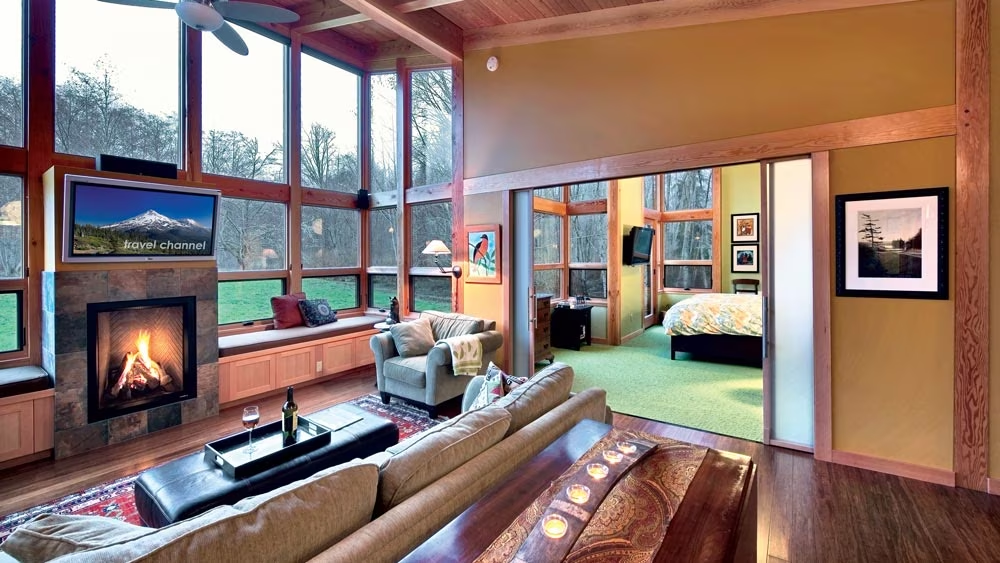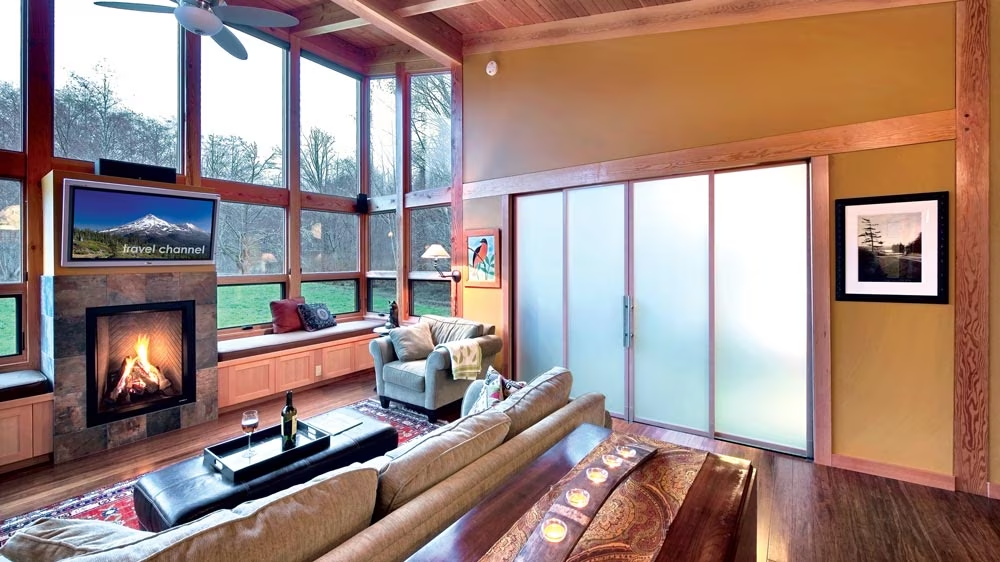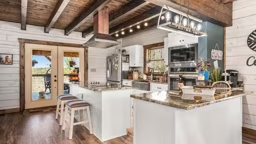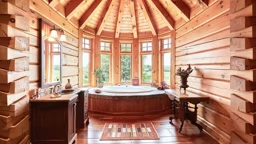If you’re looking to buy and build a log or timber home, chances are you’re thinking long term —really long term. The result of years of planning, researching and dreaming, log and timber homes are hardly ever built on a whim. In fact, they’re typically built for the current owners as well as generations to come.
So, how can you make sure this form of “forever home” addresses your wants and needs now and down the road? According to architect Deborah Pierce (author of “The Accessible Home,” The Taunton Press), the answer is accessibility.
“When most people think of accessibility, they think about a house that looks like a nursing home, but that couldn’t be further from the truth,” says Deborah. “An accessible house is just one that’s easy to take care of and live in. It’s low-maintenance and has low operating costs. Sure, if a person is getting older or has a disability, then cleaning a house or getting around is going to be difficult. But wouldn’t we all benefit from a house that’s easy to clean or easy to maneuver no matter our stage in life? That’s the principle behind accessibility.”
Deborah goes on to explain that accessible homes are “universally” designed, meaning they’re designed to be used easily by all people, regardless of ability. “I think it’s helpful to re-think accessibility as being user-friendly. Building this type of home from the start just makes good sense,” she adds.
But will building an accessible home in anticipation of your needs down the road mean you’ll have to live in a house that doesn’t feel comfortable right now? Absolutely not, says Deborah. “When you look at it in a medicinal environment, I can see why people would shy away from the idea. But if you look at this design method feature by feature, I think it’s easier to see the benefits,” she says. “For example, if you ask people if they’d like a pass-through between the garage and the kitchen so they won’t have to lug groceries through the house, they think that’s a good idea. Anytime we can simplify the activities of everyday living, we’re really streamlining our lifestyles and taking away a lot of our stress. When you look at it as easy living, people get on board.”
Log & Timber Home Accessibility
Fortunately, if you’re into log and timber frame homes, you’re already on the right track since they’re naturally accessible by design. Because of the way the weight of the home is distributed — especially in a timber home’s point-load configuration, which is carried on a system of posts and beams — interior walls are usually not load-bearing, so you’re given maximum flexibility for how you lay out the space. This gives you the opportunity to open up the hallways, entries and main living areas — all important design factors in an accessible home, according to Deborah.
“I designed and built a timber home years ago and I raised my children there, so I know firsthand how accessible these structures can be,” Deborah explains. “There are no interior partitions, so you have the benefit of wide maneuverability. Sturdy, exposed timber ceiling joists mean natural blocking for overhead lifts. Lights are wall-mounted, not recessed into the ceiling, so it’s easy to change bulbs. All these things make for a more livable home.”
So, what other elements should every accessible home include? Whether you’re starting from scratch or renovating an existing home, planning a major overhaul or making changes incrementally, Deborah suggests focusing on four main areas: entryways, kitchens, bathrooms and general flow.
Entryways
In an accessible home, you want your house to feel welcoming and comfortable from the start, which means incorporating wider doorways, safe stairways and zero-step entrances. Also think about installing grab bars, railings and safety handles. (For those with limited upper body strength, the supports might need to installed in multiple places around the house.)
Fortunately, Deborah says you can incorporate grab bars in a stylish way, through functional chair rails or elaborate handrails. “Any place where a person might be distracted or trying to get from one place to another, you really need to provide them with something to grasp,” she says.
Kitchens
All too often, as people age, they are forced to give up their houses because their kitchens are just too hard to navigate. It’s an unfortunate situation, but the good news is that it can be avoided with thoughtful planning.
“Think about how much you’d pay eating out if you couldn’t work in your kitchen,” Deborah muses. “Having a kitchen that works well for you is an economic factor as well as a convenience.”
Her suggestion: Design the space so that everything is within reach and the counters are customized (height, depth) to how they’ll be used. Should frequently accessed appliances be placed on pullout shelves or drawers? And what types of hardware will be easier to grasp as you get older? In general, pulls are a smarter choice than knobs. Also consider automated fixtures, such as motion- or voice-controlled faucets, that can make life easy if mobility becomes difficult.
Bathrooms
In accessible homes, thoughtful bathroom design is vital, says Deborah. “People spend a lot of time in the bathroom, so having that space be safe and pleasant makes it easier to live well.”
To create an accessible space, really look at how you use your bathroom. If a person has a disability or is older, it might take longer to bathe and require more space to move around, so an accessible bathroom should be larger than a standard bathroom. Tubs and showers should be oversized, too. (Deborah also recommends eliminating the raised threshold.)
Additionally, think about visibility. “Amenities like non-glare light fixtures, anti-fogging systems and proper ventilation mean accidents are less likely to happen,” says Deborah.
Flow
Perhaps the most important consideration when building an accessible home is how you’ll move around the interior spaces. “If you can’t get around or get in and out of a room easily, it’s not going to be usable. Whether that means using a wheelchair or just walking safely, it’s something you really need to think about when planning your space,” Deborah says.
To achieve this, make sure pathways are clear of obstructions, wide, well-lit and free of glares. “Many people think of passageways as leftover space in a home, but they are actually really important,” she explains. While you don’t need to incorporate all these ideas in your design, you should think about things like ramps or sloped interior walkways. Will you eventually need lifts on your stairs? Accommodating stairways generally have wider treads with shallow vertical risers.
In the end, accessibility is about living comfortably. “It’s the people who live with a disability daily who are raising the bar for the entire design and construction industry. They are the ones who are demanding homes that work better and are safer, easier to maintain and less stress-inducing,” Deborah says. “In doing so, they’re bringing ideas into the home that have universal appeal, making it easier to build our homes right the first time instead of having to make major changes in the future.”
Aging in Place
No matter if you build your home when you are 65 or 35, it makes sense to incorporate universal design elements into your plan. Even if you only choose a few, these core concepts from AARP will boost your home’s convenience and functionality today and for the years to come.
- As you age, measurements matter more, so make sure you’ve planned spaces accordingly. Entryway doors should be at least 36 inches wide, while interior door widths can range from 34 to 36 inches. Hallways should measure 42 inches across at a minimum.
- Think ahead when you’re designing the layout. By positioning at least one bedroom and one full bath on the main level, you’re setting yourself up for easier access in the future. Think about placing your washer and dryer near your primary suite, too, to make it less strenuous to haul laundry from one place to the other.
- For your home’s main living area, you should have at least one 3-foot-wide corridor that’s free of steps and other hazards to connect those spaces.
- Lighting is an easy, yet often overlooked, way to make your home more accessible. To ease stress on aging eyes, use the maximum wattage allowed in your lamps and light fixtures, and opt for a dimmer system that you can adjust as needed. Also, bump up your home’s natural light by keeping windows free of shades and curtains during the day. Lastly, make sure that all light controls, as well as electrical outlets and thermostats, are easily reached from a seated position.
- Replacing handles and hardware is an easy, cost-conscience way to allow your home to age more gracefully. Instead of choosing knobs that require twisting, choose lever-style models for your door handles, which will make them easier to operate over the years. For your cabinets, think about installing slide-out shelves for better access and replacing hard-to-grasp knobs with U-shaped handles.
- To enter the home, think about incorporating a no-step entry in the doorway you’ll use the most, whether it’s the front, back or garage door.













